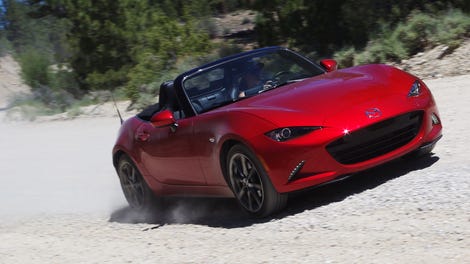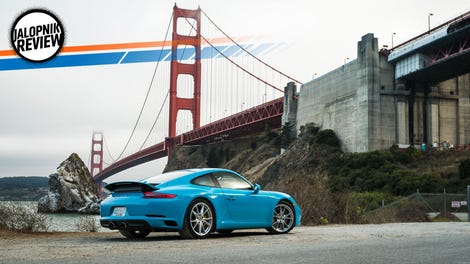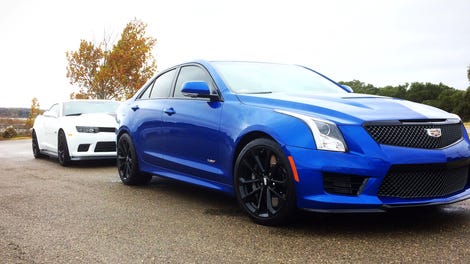The last compact crossover reviewed on Jalopnik, the 2017 Honda CR-V, generated a massive 96,000 views. That’s 66,000 more than the review of that stunning Miami Blue 2017 Porsche 911 Carrera S shot in front of the Golden Gate Bridge. Jesus, that’s like the equivalent of an entire city bridging the gap between those two articles.
Advertisement
(Full disclosure: Toyota Canada needed me to review the 2017 RAV4 so bad, they filled it up with a full tank of gas, and washed it and waxed it so much I could barely open the doors due to the fact that they had almost frozen shut from the blistering cold.)
Welcome to Jalopnik everyone, the car enthusiast website where a big purple crossover with a CVT transmission, shot in the middle of a desolate Canadian winter, spawns more interest than a road test of one of the most iconic sports cars of all time—the Porsche 911.
Advertisement
So, since you all seem to be really enjoying crossovers and buying them by the masses, I’ve decided to cram your throats with yet another one of them snooze mobiles. This time though, it’s the almighty 2017 Toyota RAV4, that other compact crossover everyone’s buying. Besides, after driving that excellent Honda, I was curious to find out how this aging RAV4 is holding up. So here goes.
Sigh.
The OG Crossover
It’s interesting that I pitted the Toyota RAV4 and the Honda CR-V back-to-back, because these two car-based utility vehicles were critical in popularizing the crossover segment back when they were released in the mid-1990s. The RAV4 came first, so it gets the merit of being the father of this somewhat irritating vehicular domination. I’m not sure if I should praise the RAV4 or despise it because of this, but at least it’s kicking ass at something.
Sponsored
I’m sure you’ll agree with me that this trend of driving a lifted all-wheel drive automobile that’s good at everything but excels at nothing remains a very fascinating, if not difficult to comprehend phenomenon. But with the RAV4, Toyota really knows what it’s doing.
Because although the Honda CR-V holds the title for the best-selling SUV in America, this RAV4 isn’t far behind in second place. And here in Canada, it happens to be our best-seller, with a total of 49,103 units sold in 2016. Meanwhile, Volkswagen is still dreaming of selling that many Tiguans.
It’s also debatable how “compact” the RAV4 and CR-V really are these days, given that they’re bigger than ever and stuff like the HR-V exists now. But that’s what they call ‘em. I don’t make the rules here.
Advertisement
Advertisement
And at first sight, it’s not like the RAV4 seems to offer anything more than all the other “compact” crossovers available out there. Think Nissan Rogue, Ford Escape, Kia Sportage, Hyundai Tucson, Mazda CX-5, Jeep Cherokee, Chevrolet Equinox, and that VW Tiguan. There’s a whole crop of 7-passenger utility vehicles now too, luxury ones, strange coupe-like ones, electric ones, and now, subcompact ones that are also becoming insanely popular.
This is our automotive industry, where the car is actually becoming extinct. Don’t blame me, I’m not the one buying those damn things!
That being said, several of the crossovers I listed up there are actually quite attractive, and in some cases, more fun to drive (I never thought I’d say this about this type of vehicle) and better appointed than the RAV4.
Advertisement
But none of them, except maybe the Ford Escape, can even come close to the Toyota’s sales numbers. And this is where things suddenly become very interesting.
So, Why Are We Buying These Things Again?
I must say, from the outside, I actually prefer the RAV4’s proportions and overall design than the very robotic and bloated CR-V, and ever since the RAV4 was given the whole LED treatment front and rear, as well as updated front and rear bumpers, it still manages to actually look decent—and relatively compact.
Under the hood, again, nothing revolutionary. It’s the tried and tested 2.5-liter four good for 176 horsepower and 172 lb-ft of torque, numbers that are somewhat disappointing compared to the CR-V. No turbo or direct injection is available.
Advertisement
Advertisement
This is sad, because there used to be a time when you could buy a V6-powered RAV4 that could outrun a Lexus IS. The same goes for the transmission, it’s a conventional 6-speed automatic, and although I did enjoy Honda’s CVT, I must say, even the most boring of automatic transmissions feels more mechanical than that other gearless system.
But the engine is downright anemic. Even if you know it will keep on going forever, it really gives the RAV4 that sluggish, mid-1990s entry level sense of acceleration where you constantly need to keep that right foot planted to get any overtaking accomplished.
The CR-V at least had some good old Honda fun injected into it. When you punched the accelerator, it got up and went.
Advertisement
None of that really happens in the RAV4. Smash the go pedal and that 2.5L buzzes through the engine bay as the 6-speed slushbox attempts to find the best gear to save fuel instead of actually accelerating. To Toyota’s credit, the transmission works accurately and smoothly – it’s fine.
The 0-60 mph times speak for themselves: the RAV4 takes 8.4 seconds to achieve the stunt, almost a full second behind the Honda. Steering is also quite lifeless and vague. Basically, there’s just no fun that can be had from this crossover. But then, is that what buyers will actually want from it?
Lexus Smooth
Driving this RAV4 was actually quite a revelation at how good Toyota is at building solid-feeling machines on wheels. Even if the RAV4’s platform is a few years older than the CR-V’s, I was impressed at how quiet and smooth it is behind the wheel. Sound insulation is superb, arguably the best in the segment.
Advertisement
Advertisement
There’s a Lexus-like overall sense of excellent build quality that’s instantly felt throughout the entire cabin. And the suspension, while being soft and wobbly, does a fantastic at taking on Montreal potholes.
Unfortunately, that’s the only good thing I can say about the RAV4’s driving dynamics – because there aren’t any. I wish I could have at least tried it in the snow to sample Toyota’s Torque-Control all-wheel drive system. But there’s just no more snow left in Québec anymore. Which is alarming.
Inside, the RAV4 is well appointed and comfortable, at least my tester was, because of course, Toyota lent me a fully loaded Platinum model. That means I had sumptuous leather, chrome all over the place, and questionable faux marble trim on the doors and center console.
Advertisement
I certainly hope Toyota was trying to mimic marble, because I have no idea what else that’s supposed to be.
I’m especially fond of the stitched leather that crosses the dashboard. I’m not a big fan of how you sit upright in this thing though, but that’s because I’m huge. I’m sure family moms or dads will feel safe in the RAV4 because of that.
The infotainment system is that classic Toyota interface found in all their cars which is, to be fair, showing its age more than a little bit. It’s more frustrating and dated than most of its competitors, but still, the controls remain a lot easier to find than in the CR-V.
Advertisement
Advertisement
Also, some of the vehicle’s controls, such as driving modes or heated seats sit low under the center stack, making them hard to reach, especially for people with dwarf-like arms like my photographer Myle. Finally, I can’t say the dashboard design is attractive—it looks more like the result of a design competition where everyone somehow won.
Yes, there are actually drive modes in the RAV4—Sport and Eco. Sport does absolutely nothing more than make the transmission suddenly become frantic and Eco just cuts off any sort of power the RAV4 already doesn’t have. I swear, I never noticed a difference in fuel economy when driving around in Eco.
My RAV4 did come with a seriously cool 360 degree security camera to see if there’s a thug waiting for you outside the car to steal your money. I like that. And it’s definitely going to be a hit with soccer moms.
Sensible And Practical
Really, what you should know about the RAV4 is that it’s nothing more than a practical and sensible utility vehicle. It’ll probably never break down, the rear seat is roomy and comfortable, and when it’s lowered, it’ll give way to 73.4 cu. ft. of cargo space, 2.6 cu. ft. less than the CR-V, but still not negligible.
Advertisement
When the rear seat is folded back up (because I know you’ll ask me this in the comments), the RAV4 gives way to 38.4 cu. ft., still 0.6 cu. ft. less than the Honda. And the RAV4 gets a trunk floor that can be positioned in two different heights which adds an extra layer of practicality. Hooray.
Pricing for the 2017 Toyota RAV4 starts at $24,910 for a base LE 2WD model. AWD RAV4s start at $26,310, with the ultimately equipped Platinum model you see here topping the range at $36,150.
Advertisement
Toyota will also sell you a hybrid RAV4, an advantage over Honda that doesn’t offer any hybrid crossovers in its lineup at all. That one sells for $29,030.
So, let’s sum it all up: the 2017 Toyota RAV4 has decent looks, but doesn’t look more exciting than the rest of the crossovers on the market. It’s also less fuel efficient (compare numbers at the bottom of this post), less fun to drive, and not that much more practical than its direct competitor, the Honda CR-V, but it’s more expensive? So, why are we buying them?
Truth is, no matter how midpack the RAV4 will be, people will still run straight into a Toyota dealership with their eyes shut to buy one instead of a Tucson or a CX-5. Because it’s a Toyota. Their parents had one. Their grandparents had one. And the guy on TV told them to buy one.
Advertisement
This is actually a good and honest vehicle. It’s just boring as hell. The funniest part out of all this, is that Toyota knows exactly what it’s selling, and understands that a vehicle that’s well assembled and lasts forever will outsell anything—even if it excels at nothing.
Can I please get back to reviewing cool shit now?
Engine: 2.5L inline four
Power: 176 HP at 6,000 RPM / 172 lb-ft at 4,100 RPM
Transmission: 6-speed automatic
0-60 Time: 8.4 seconds (claimed)
Top Speed: 108 MPH (governor limited)
Drivetrain: Front or all-wheel drive
Curb Weight: 3,678 pounds
Seating: 5 people
MPG: 22 City / 29 Highway (from EPA)
MSRP: $24,910 base 2WD, $36,150 for Platinum AWD
William Clavey is an automotive journalist from Montréal, Québec, Canada. He runs claveyscorner.com, and does some collaborative writing over at rightfootdown.com.

















